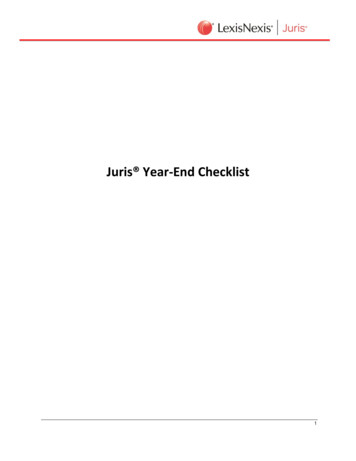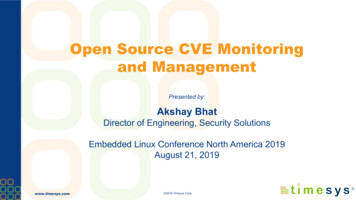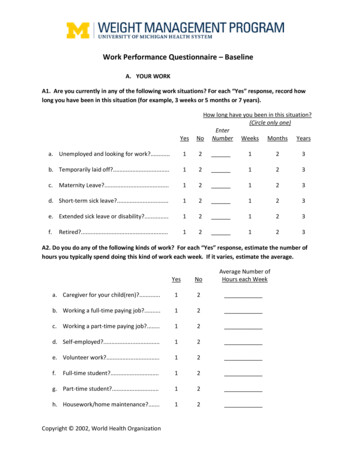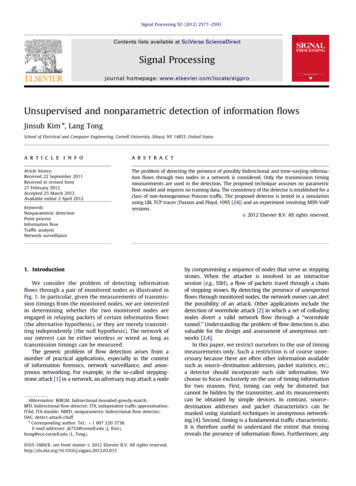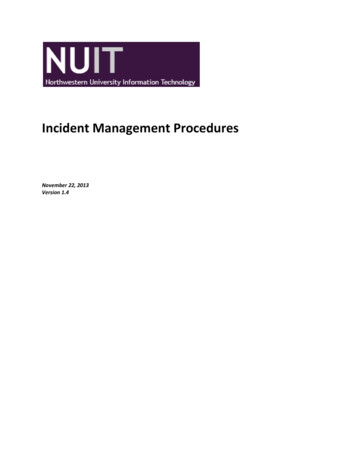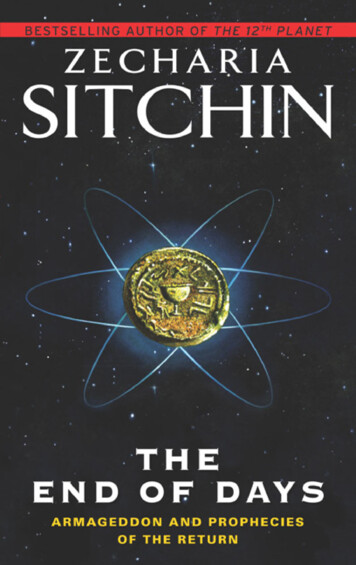
Transcription
ZECHARIASITCHINTHEEND OF DAYSA R M AG E D D O N A N D PR O PH EC I ESOF THE RETURNThe 7th and Concluding Bookof The Earth ChrChroniclesonicles
Dedicatedto my brotherDr. Amnon Sitchin,whose aerospace expertisewas invaluable at all times
CONTENTSPreface:The Past, The Futurev1.The Messianic Clock12.“And It Came to Pass”193.Egyptian Prophecies, Human Destinies334.Of Gods and Demigods475.Countdown to Doomsday636.Gone with the Wind797.Destiny Had Fifty Names978.In the Name of God1179.The Promised Land13610.The Cross on the Horizon15711.The Day of the Lord17712.Darkness at Noon19813.When the Gods Left Earth22414.The End of Days25015.Jerusalem: A Chalice, Vanished26816.Armageddon and Propheciesof the Return289
About the AuthorPraiseOther Books by Zecharia SitchinCoverCopyrightAbout the Publisher
PREFACE:THE PAST, THE FUTURE“When will they return?”I have been asked this question countless times by peoplewho have read my books, the “they” being the Anunnaki—the extraterrestrials who had come to Earth from their planetNibiru and were revered in antiquity as gods. Will it bewhen Nibiru in its elongated orbit returns to our vicinity,and what will happen then? Will there be darkness atnoon and the Earth shall shatter? Will it be Peace on Earth,or Armageddon? A Millennium of trouble and tribulations,or a messianic Second Coming? Will it happen in 2012, orlater, or not at all?These are profound questions that combine people’s deepest hopes and anxieties with religious beliefs and expectations, questions compounded by current events: wars inlands where the entwined affairs of gods and men began;the threats of nuclear holocausts; the alarming ferocity ofnatural disasters. They are questions that I dared not answerall these years—but now are questions the answers to whichcannot—must not—be delayed.Questions about the Return, it ought to be realized, are notnew; they have inexorably been linked in the past—as theyare today—to the expectation and the apprehension of theDay of the Lord, the End of Days, Armageddon. Four millennia ago, the Near East witnessed a god and his son promisingHeaven on Earth. More than three millennia ago, king andpeople in Egypt yearned for a messianic time. Two millenniaago, the people of Judea wondered whether the Messiah hadappeared, and we are still seized with the mysteries of thoseevents. Are prophecies coming true?
viPREFACEWe shall deal with the puzzling answers that were given,solve ancient enigmas, decipher the origin and meaningof symbols—the Cross, the Fishes, the Chalice. We shalldescribe the role of space-related sites in historic events, andshow why Past, Present and Future converge in Jerusalem,the place of the “Bond Heaven-Earth.” And we shall ponderwhy it is that our current twenty-first century a.d. is sosimilar to the twenty-first century b.c.e. Is history repeatingitself—is it destined to repeat itself? Is it all guided by aMessianic Clock? Is the time at hand?More than two millennia ago, Daniel of Old Testamentfame repeatedly asked the angels: When? When will be theEnd of Days, the End of Time? More than three centuriesago the famed Sir Isaac Newton, who elucidated the secretsof celestial motions, composed treatises on the Old Testament’s Book of Daniel and the New Testament’s Book ofRevelation; his recently found handwritten calculations concerning the End of Days will be analyzed, along with morerecent predictions of The End.Both the Hebrew Bible and the New Testament assertedthat the secrets of the Future are embedded in the Past, thatthe destiny of Earth is connected to the Heavens, that the affairs and fate of Mankind are linked to those of God andgods. In dealing with what is yet to happen, we cross overfrom history to prophecy; one cannot be understood withoutthe other, and we shall report them both. With that as ourguide, let us look at what is to come through the lens of whathad been. The answers will be certain to surprise.Zecharia SitchinNew York, November 2006
1THE MESSIANIC CLOCKWherever one turns, humankind appears seized with Apocalyptic trepidation, Messianic fervor, and End of Time anxiety.Religious fanaticism manifests itself in wars, rebellions,and the slaughter of “infidels.” Armies amassed by Kings ofthe West are warring with armies of the Kings of the East. AClash of Civilizations shakes the foundations of traditionalways of life. Carnage engulfs cities and towns; the high andthe mighty seek safety behind protective walls. Natural calamities and ever-intensifying catastrophies leave peoplewondering: Has Mankind sinned, is it witnessing DivineWrath, is it due for another annihilating Deluge? Is this theApocalypse? Can there be—will there be—Salvation? AreMessianic times afoot?The time—the twenty-first century a.d.—or was it thetwenty-first century b.c.e.?The correct answer is Yes and Yes, both in our own timeas well as in those ancient times. It is the condition of thepresent time, as well as at a time more than four millenniaago; and the amazing similarity is due to events in the middletime in between—the period associated with the messianicfervor at the time of Jesus.Those three cataclysmic periods for Mankind and itsplanet—two in the recorded past (circa 2100 b.c.e. and whenb.c.e. changed to a. d.), one in the nearing future—are interconnected; one has led to the other, one can be understoodonly by understanding the other. The Present stems from thePast, the Past is the Future. Essential to all three is Messianic Expectation; and linking all three is Prophecy.
2THE END OF DAYSHow the present time of troubles and tribulations willend—what the Future portends—requires entering the realmof Prophecy. Ours will not be a mélange of newfound predictions whose main magnet is fear of doom and End, but areliance upon unique ancient records that documented thePast, predicted the Future, and recorded previous Messianicexpectations—prophesying the future in antiquity and, onebelieves, the Future that is to come.In all three apocalyptic instances—the two that had occurred, the one that is about to happen—the physical andspiritual relationship between Heaven and Earth was and remains pivotal for the events. The physical aspects were expressed by the existence on Earth of actual sites that linkedEarth with the heavens—sites that were deemed crucial, thatwere focuses of the events; the spiritual aspects have beenexpressed in what we call Religion. In all three instances, achanged relationship between Man and God was central, except that when, circa 2100 b.c.e., Mankind faced the first ofthese three epochal upheavals, the relationship was betweenmen and gods, in the plural. Whether that relationship has really changed, the reader will soon discover.The story of the gods, the Anunnaki (“Those who fromheaven to Earth came”), as the Sumerians called them, begins with their coming to Earth from Nibiru in need of gold.The story of their planet was told in antiquity in the Epic ofCreation, a long text on seven tablets; it is usually consideredto be an allegorical myth, the product of primitive minds thatspoke of planets as living gods combating each other. But asI have shown in my book The Twelfth Planet, the ancient textis in fact a sophisticated cosmogony that tells how a strayplanet, passing by our solar system, collided with a planetcalled Tiamat; the collision resulted in the creation of Earthand its Moon, of the Asteroid Belt and comets, and in thecapture of the invader itself in a great elliptical orbit thattakes about 3,600 Earth-years to complete (Fig. 1).It was, Sumerian texts tell, 120 such orbits—432,000Earth-years—prior to the Deluge (the “Great flood”) that theAnunnaki came to Earth. How and why they came, their first
The Messianic Clock3Figure 1cities in the E.DIN (the biblical Eden), their fashioning of theAdam and the reasons for it, and the events of the catastrophic Deluge—have all been told in The Earth Chroniclesseries of my books, and will not be repeated here. But beforewe time-travel to the momentous twenty-first century b.c.e.,some pre-Diluvial and post-Diluvial landmark events needto be recalled.The biblical tale of the Deluge, starting in chapter 6 ofGenesis, ascribes its conflicting aspects to a sole deity, Yahweh, who at first is determined to wipe Mankind off the faceof the Earth, and then goes out of his way to save it throughNoah and the Ark. The earlier Sumerian sources of the taleascribe the disaffection with Mankind to the god Enlil, andthe countereffort to save Mankind to the god Enki. What theBible glossed over for the sake of Monotheism was not justthe disagreement between Enlil and Enki, but a rivalry and aconflict between two clans of Anunnaki that dominated thecourse of subsequent events on Earth.That conflict between the two and their offspring, and theEarth regions allocated to them after the Deluge, need to bekept in mind to understand all that happened thereafter.The two were half-brothers, sons of Nibiru’s ruler Anu;their conflict on Earth had its roots on their home planet, Nibiru. Enki—then called E.A (“He whose home is water”)—was Anu’s firstborn son, but not by the official spouse, Antu.When Enlil was born to Anu by Antu—a half-sister ofAnu—Enlil became the Legal Heir to Nibiru’s throne though
4THE END OF DAYShe was not the firstborn son. The unavoidable resentment onthe part of Enki and his maternal family was exacerbated bythe fact that Anu’s accession to the throne was problematic tobegin with: having lost out in a succession struggle to a rivalnamed Alalu, he later usurped the throne in a coup d’état,forcing Alalu to flee Nibiru for his life. That not only backtracked Ea’s resentments to the days of his forebears, but alsobrought about other challenges to the leadership of Enlil, astold in the epic Tale of Anzu. (For the tangled relationships ofNibiru’s royal families and the ancestries of Anu and Antu,Enlil and Ea, see The Lost Book of Enki .)The key to unlocking the mystery of the gods’ succession(and marriage) rules was my realization that these rules alsoapplied to the people chosen by them to serve as their proxiesto Mankind. It was the biblical tale of the Patriarch Abrahamexplaining (Genesis 20:12) that he did not lie when he had presented his wife Sarah as his sister: “Indeed, she is my sister, thedaughter of my father, but not the daughter of my mother, andshe became my wife.” Not only was marrying a half-sister froma different mother permitted, but a son by her—in this caseIsaac—became the Legal Heir and dynastic successor, ratherthan the Firstborn Ishmael, the son of the handmaiden Hagar.(How such succession rules caused the bitter feud between Ra’sdivine descendants in Egypt, the half-brothers Osiris and Sethwho married the half-sisters Isis and Nephtys, is explained inThe Wars of Gods and Men.)Though those succession rules appear complex, they werebased on what those who write about royal dynasties call“bloodlines”—what we now should recognize as sophisticatedDNA genealogies that also distinguished between generalDNA inherited from the parents as well as the mitochondrialDNA (mtDNA) that is inherited by females only from themother. The complex yet basic rule was this: Dynastic linescontinue through the male line; the Firstborn son is next insuccession; a half-sister could be taken as wife if she had adifferent mother; and if a son by such a half-sister is laterborn, that son—though not Firstborn—becomes the LegalHeir and the dynastic successor.The rivalry between the two half-brothers Ea/Enki and En-
The Messianic Clock5lil in matters of the throne was complicated by personal rivalry in matters of the heart. They both coveted theirhalf-sister Ninmah, whose mother was yet another concubineof Anu. She was Ea’s true love, but he was not permitted tomarry her. Enlil then took over, and had a son by her—Ninurta. Though born without wedlock, the succesion rules madeNinurta Enlil’s uncontested heir, being both his Firstborn sonand one born by a royal half-sister.Ea, as related in The Earth Chronicles books, was the leaderof the first group of fifty Anunnaki to come to Earth to obtainthe gold needed to protect Nibiru’s dwindling atmosphere.When the initial plans failed, his half-brother Enlil was sent toEarth with more Anunnaki for an expanded Mission Earth. Ifthat was not enough to create a hostile atmosphere, Ninmahtoo arrived on Earth to serve as chief medical officer . . .A long text known as the Atrahasis Epic begins the story ofgods and men on Earth with a visit by Anu to Earth to settleonce and for all (he hoped) the rivalry between his two sonsthat was ruining the vital mission; he even offered to stay onEarth and let one of the half-brothers assume the regency onNibiru. With that in mind, the ancient text tells us, lots weredrawn to determine who would stay on Earth and who wouldsit on Nibiru’s throne:The gods clasped hands together,had cast lots and had divided:Anu went up [back] to heaven,[For Enlil] the Earth was made subject;The seas, enclosed as with a loop,to Enki the prince were given.The result of drawing lots, then, was that Anu returned toNibiru as its king. Ea, given dominion over the seas and waters (in later times, “Poseidon” to the Greeks and “Neptune”to the Romans), was granted the epithet EN.KI (“Lord ofEarth”) to soothe his feelings; but it was EN.LIL (“Lord ofthe Command”) who was put in overall charge: “To him theEarth was made subject.” Resentful or not, Ea/Enki could
6THE END OF DAYSnot defy the rules of succession or the results of the drawingof lots; and so the resentment, the anger at justice denied, anda consuming determination to avenge injustices to his fatherand forefathers and thus to himself led Enki’s son Mardukto take up the fight.Several texts describe how the Anunnaki set up their settlements in the E.DIN (the post-Diluvial Sumer), each with aspecific function, and all laid out in accordance with a master plan. The crucial space connection—the ability to constantly stay in communication with the home planet and withthe shuttlecraft and spacecraft—was maintained from Enlil’scommand post in Nippur, the heart of which was a dimly litchamber called the DUR.AN.KI, “The Bond Heaven-Earth.”Another vital facility was a spaceport, located at Sippar(“Bird City”). Nippur lay at the center of concentric circles atwhich the other “cities of the gods” were located; all togetherthey shaped out, for an arriving spacecraft, a landing corridor whose focal point was the Near East’s most visible topographic feature—the twin peaks of Mount Ararat (Fig. 2).And then the Deluge “swept over the earth,” obliterated allthe cities of the gods with their Mission Control Center andSpaceport, and buried the Edin under millions of tons ofmud and silt. Everything had to be done all over again—butmuch could no longer be the same. First and foremost, it wasnecessary to create a new spaceport facility, with a new Mission Control Center and new Beacon-sites for a LandingCorridor. The new landing path was anchored again on theprominent twin peaks of Ararat; the other components wereall new: the actual spaceport in the Sinai Peninsula, on the 30thparallel north; artificial twin peaks as beacon sites, the Gizapyramids; and a new Mission Control Center at a place calledJerusalem (Fig. 3). It was a layout that played a crucial role inpost-Diluvial events.The Deluge was a watershed (both literally and figuratively)in the affairs of both gods and men, and in the relationshipbetween the two: the Earthlings, who were fashioned to serveand work for the gods were henceforth treated as junior partners on a devastated planet.
The Messianic Clock7Figure 2The new relationship between men and gods was formulated, sanctified, and codified when Mankind was grantedits first high civilization, in Mesopotamia, circa 3800 b.c.e.The momentous event followed a state visit to Earth by Anu,not just as Nibiru’s ruler but also as the head of the pantheon,on Earth, of the ancient gods. Another (and probably themain) reason for his visit was the establishment and affirmation of peace among the gods themselves—a live-and-let-livearrangement dividing the lands of the Old World among thetwo principal Anunnaki clans, that of Enlil and that of Enki—for the new post-Diluvial circumstances and the new locationof the space facilities required a new territorial divisionamong the gods.
8THE END OF DAYSFigure 3It was a division that was reflected in the biblical Table ofNations (Genesis, chapter 10), in which the spread of Mankind, emanating from the three sons of Noah, was recordedby nationality and geography: Asia to the nations/lands ofShem, Europe to the descendants of Japhet, Africa to the nation/lands of Ham. The historical records show that the parallel division among the gods allotted the first two to theEnlilites, the third one to Enki and his sons. The connecting
The Messianic Clock9Sinai peninsula, where the vital post-Diluvial spaceport waslocated, was set aside as a neutral Sacred Region.While the Bible simply listed the lands and nations according to their Noahite division, the earlier Sumerian textsrecorded the fact that the division was a deliberate act, theresult of deliberations by the leadership of the Anunnaki. Atext known as the Epic of Etana tells us thatThe great Anunnaki who decree the fatessat exchanging their counsels regarding the Earth.They created the four regions,set up the settlements.In the First Region, the lands between the two rivers Euphrates and Tigris (Mesopotamia), Man’s first known high civilization, that of Sumer, was established. Where the prediluvialcities of the gods had been, Cities of Man arose, each with itssacred precinct where a deity resided in his or her ziggurat—Enlil in Nippur, Ninmah in Shuruppak, Ninurta inLagash, Nannar/Sin in Ur, Inanna/Ishtar in Uruk, Utu/Shamash in Sippar, and so on. In each such urban center anEN.SI, a “Righteous Shepherd”—initially a chosen demigod—was selected to govern the people in behalf of thegods; his main assignment was to promulgate codes of justice and morality. In the sacred precinct, a priesthood overseen by a high priest served the god and his spouse,supervised the holiday celebrations, and handled the rites ofofferings, sacrifices, and prayers to the gods. Art and sculpture, music and dance, poetry and hymns, and above all writing and recordkeeping flourished in the temples and extendedto the royal palace.From time to time one of those cities was selected to serveas the land’s capital; there the ruler was king, LU.GAL(“Great man”). Initially and for a long time thereafter thisperson, the most powerful man in the land, served as bothking and high priest. He was carefully chosen, for his roleand authority, and all the physical symbols of Kingship, weredeemed to have come to Earth directly from Heaven, fromAnu on Nibiru. A Sumerian text dealing with the subject
10THE END OF DAYSstated that before the symbols of Kingship (tiara/crown andscepter) and of Righteousness (the shepherd’s staff ) weregranted to an earthly king, they “lay deposited before Anu inheaven.” Indeed, the Sumerian word for Kingship was Anuship.This aspect of “Kingship” as the essence of civilization,just behavior and a moral code for Mankind, was explicitlyexpressed in the statement, in the Sumerian King List, thatafter the Deluge “Kingship was brought down from Heaven.”It is a profound statement that must be borne in mind as weprogress in this book to the messianic expectations—in thewords of the New Testament, for the Return of the “Kingship of Heaven” to Earth.Circa 3100 b.c.e. a similar yet not identical civilizationwas established in the Second Region in Africa, that of theriver Nile (Nubia and Egypt). Its history was not as harmonious as that among the Enlilites, for rivalry and contentioncontinued among Enki’s six sons, to whom not cities butwhole land domains were allocated. Paramount was an ongoing conflict between Enki’s firstborn Marduk (Ra in Egypt)and Ningishzidda (Thoth in Egypt), a conflict that led to theexile of Thoth and a band of African followers to the NewWorld (where he became known as Quetzalcóatl, the WingedSerpent). Marduk/Ra himself was punished and exiled when,opposing the marriage of his young brother Dumuzi to Enlil’s granddaughter Inanna/Ishtar, he caused his brother’sdeath. It was as compensation to Inanna/Ishtar that she wasgranted dominion over the Third Region of civilization, thatof the Indus Valley, circa 2900 b.c.e. It was for good reasonthat the three civilizations—as was the spaceport in the sacred region—were all centered on the 30th parallel north(Fig. 4).According to Sumerian texts, the Anunnaki establishedKingship—civilization and its institutions, as most clearlyexemplified in Mesopotamia—as a new order in their relationships with Mankind, with kings/priests serving both as alink and a separator between gods and men. But as one looksback on that seemingly “golden age” in the affairs of godsand men, it becomes evident that the affairs of the gods con-
The Messianic Clock11Figure 4stantly dominated and determined the affairs of Men and thefate of Mankind. Overshadowing all was the determinationof Marduk/Ra to undo the injustice done to his father Ea/Enki, when under the succession rules of the Anunnaki notEnki but Enlil was declared the Legal Heir of their fatherAnu, the ruler on their home planet Nibiru.In accord with the sexagesimal (“base sixty”) mathematicalsystem that the gods granted the Sumerians, the twelve greatgods of the Sumerian pantheon were given numerical ranks inwhich Anu held the supreme Rank of Sixty; the Rank of Fiftywas granted to Enlil; that of Enki was forty, and so fartherdown, alternating between male and female deities (Fig. 5).
12THE END OF DAYSUnder the succession rules, Enlil’s son Ninurta was in line forthe rank of fifty on Earth, while Marduk held a nominal rankof ten; and initially, these two successors-in-waiting were notyet part of the twelve “Olympians.”And so the long, bitter, and relentness struggle by Mardukthat began with the Enlil–Enki feud focused later on Marduk’s contention with Enlil’s son Ninurta for the successionto the Rank of Fifty, and then extended to Enlil’s granddaughter Inanna/Ishtar, whose marriage to Dumuzi, Enki’syoungest son, was so opposed by Marduk that it ended withDumuzi’s death. In time Marduk/Ra faced conflicts evenFigure 5
The Messianic Clock13with other brothers and half-brothers of his, in addition to theconflict with Thoth that we have already mentioned—principally with Enki’s son Nergal, who married a granddaughterof Enlil named Ereshkigal.In the course of these struggles, the conflicts at timesflared up to full-fledged wars between the two divine clans;some of those wars are called “The Pyramid Wars” in mybook The Wars of Gods and Men. In one notable instance thefighting led to the burying alive of Marduk inside the GreatPyramid; in another, it led to its capture by Ninurta. Mardukwas also exiled more than once—both as punishment and asa self-imposed absence. His persistent efforts to attain thestatus to which he believed he was entitled included the eventrecorded in the Bible as the Tower of Babel incident; but inthe end, after numerous frustrations, success came only whenEarth and Heaven were aligned with the Messianic Clock.Indeed, the first cataclysmic set of events, in the twentyfirst century b.c.e., and the Messianic expectations that accompanied it, is principally the story of Marduk; it alsobrought to center stage his son Nabu—a deity, the son of agod, but whose mother was an Earthling.Throughout the history of Sumer that spanned almost twothousand years, its royal capital shifted—from the first one,Kish (Ninurta’s first city), to Uruk (the city that Anu grantedto Inanna/Ishtar) to Ur (Sin’s seat and center of worship);then to others and then back to the initial ones; and finally,for the third time, back to Ur. But at all times Enlil’s cityNippur, his “cult center,” as scholars are wont to call it, remained the religious center of Sumer and the Sumerian people; it was there that the annual cycle of worshipping thegods was determined.The twelve “Olympians” of the Sumerian pantheon, eachwith his or her celestial counterpart among the twelve members of the Solar System (Sun, Moon, and ten planets, including Nibiru), were also honored with one month each in theannual cycle of a twelve-month year. The Sumerian term for“month,” EZEN, actually meant holiday, festival; and eachsuch month was devoted to celebrating the worship-festival of
14THE END OF DAYSone of the twelve supreme gods. It was the need to determinethe exact time when each such month began and ended (andnot in order to enable peasants to know when to sow or harvest, as schoolbooks explain) that led to the introduction ofMankind’s first calendar in 3760 b.c.e. It is known as theCalendar of Nippur because it was the task of its priests todetermine the calendar’s intricate timetable and to announce,for the whole land, the time of the religious festivals. Thatcalendar is still in use to this day as the Jewish religious calendar, which, in a.d. 2007, numbers the year as 5767.In pre-Diluvial times Nippur served as Mission ControlCenter, Enlil’s command post where he set up the DUR.AN.KI, the “Bond Heaven-Earth” for the communications withthe home planet Nibiru and with the spacecraft connectingthem. (After the Deluge, these functions were relocated to aplace later known as Jerusalem.) Its central position, equidistant from the other functional centers in the E.DIN (see Fig. 2),was also deemed to be equidistant from the “four corners ofthe Earth” and gave it the nickname “Navel of the Earth.” Ahymn to Enlil referred to Nippur and its functions thus:Enlil,When you marked off divine settlements on Earth,Nippur you set up as your very own city . . .You founded the Dur-An-KiIn the center of the four corners of the Earth.(The term “the Four Corners of the Earth” is also found inthe Bible; and when Jerusalem replaced Nippur as MissionControl Center after the Deluge, it too was nicknamed theNavel of the Earth.)In Sumerian the term for the four regions of the Earthwas UB, but it also is found as AN.UB—the heavenly, thecelestial four “corners”—in this case an astronomical termconnected with the calendar. It is taken to refer to the fourpoints in the Earth-Sun annual cycle that we nowadays callthe Summer Solstice, the Winter Solstice, and the two crossings of the equator—once as the Spring Equinox and then asthe Autumnal Equinox. In the Calendar of Nippur, the year
The Messianic Clock15began on the day of the Spring Equinox and it has so remained in the ensuing calendars of the ancient Near East.That determined the time of the most important festival ofthe year—the New Year festival, an event that lasted tendays, during which detailed and canonized rituals had tobe followed.Determining calendrical time by Heliacal Rising entailedthe observation of the skies at dawn, when the sun just begins to rise on the eastern horizon but the skies are still darkenough to show the stars in the background. The day of theequinox having been determined by the fact that on it daylight and nighttime were precisely equal, the position of thesun at heliacal rising was then marked by the erection of astone pillar to guide future observations—a procedure thatwas followed, for example, later on at Stonehenge in Britain;and, as at Stonehenge, long-term observations revealed thatthe group of stars (“constellation”) in the background hasnot remained the same (Fig. 6); there, the alignment stonecalled the “Heel Stone” that points to sunrise on solstice dayFigure 6
16THE END OF DAYSnowadays, pointed originally to sunrise circa 2000 b.c.e.The phenomenon, called Precession of the Equinoxes orjust Precession, results from the fact that as the Earth completes one annual orbit around the Sun, it does not return tothe same exact celestial spot. There is a slight, very slightretardation; it amounts to one degree (out of 360 in the circle)in 72 years. It was Enki who first grouped the stars observable from Earth into “constellations,” and divided the heavens in which the Earth circled the sun into twelve parts—whathas since been called the Zodiacal Circle of constellations(Fig. 7). Since each twelfth part of the circle occupied 30degrees of the celestial arc, the retardation or Precessionalshift from one Zodiacal House to another lasted (mathematically) 2,l60 years (72 30), and a complete zodiacal cyclelasted 25,920 years (2,l60 l2). The approximate dates ofthe Zodiacal Ages—following the equal twelve-part division and not actual astronomical observations—have beenadded here for the reader’s guidance.Figure 7
The Messianic Clock17That this was the achievement from a time precedingMankind’s civilizations is attested to by the fact that a zodiacal calendar was applied to Enki’s first stays on Earth (whenthe first two zodiacal houses were named in his honor); thatthis was not the achievement of a Greek astronomer (Hipparchus) in the third century b.c.e. (as most textbooks stillsuggest), is attested by the fact that the twelve zodiacal houseswere known to the Sumerians millennia earlier by names(Fig. 8) and depictions (Fig. 9) that we use to this day.Figure 8In When Time Began the calendrical timetables of godsand men were discussed at length. Having come from Nibiru,whose orbital period, the SAR, meant 3,600 (Earth-) years,that unit was naturally the first calendrical yardstick of theAnunnaki even on the fast-orbiting Earth. Indeed, the textsdealing with their early days on Earth, such as the SumerianKing Lists, designated the periods of this or that leader’s timeon Earth in terms of Sars. I termed this Divine Time. Thecalendar granted to Mankind, one based on the orbital aspects of the Earth (and its Moon), was named Earthly Time.Pointing out that the 2,l60-year zodiacal shift
ZECHARIA SITCHIN. THE. END OF DAYS. ARMAGEDDON AND PROPHECIES OF THE RETURN . The The 7th and Concluding Book 7th and Concluding Book of The The Earth Chr Earth Chronicles. . who have read my books, the “they” being the Anunnaki— the extraterrestrials who had come to Earth



